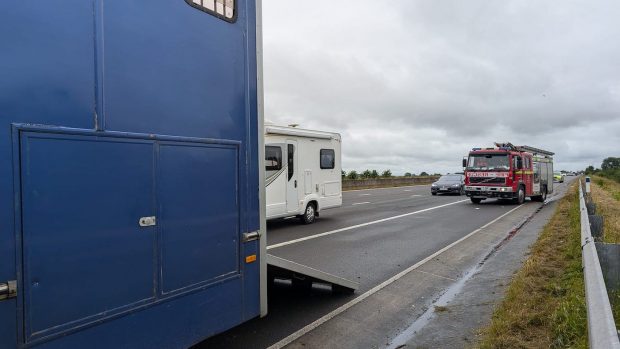Competition horses are no strangers to life on the road — but the lifestyle can cause havoc with their routine. Find out how best to navigate feeding on the move
From March until October four-star eventer Georgie Spence and her string of horses will become accustomed to life on the lorry.
With early starts, late nights and long journeys to contend with, how does the Wiltshire-based 27-year-old — and other top riders like her — make sure her horses step off the lorry in peak condition?
“Feeding when we go to a competition is quite easy,” says Georgie, who has perfected her competition routine, having competed at her first Badminton in 2008 at the age of just 19.
“I always like to feed the horses at least an hour before they leave. This is quite straightforward as we normally need an hour to get ready in the mornings anyway,” she says.
“If the horse is a fussy eater, I would turn off the lights to let them eat in peace rather
than mucking out around them and potentially putting them off their feed.”
Sticking to a routine
While travelling can be stressful, keeping your horse’s feeding regime as consistent as possible will help keep anxiety levels to a minimum.
“The change in routine that is likely to come from competition travelling is the main concern [for horse owners],” says Saracen Horse Feeds’ Lizzie Drury. “This can include feeding times, the order of feeding when you’re in temporary stabling with lots of other horses as well as [different] exercise patterns — particularly an issue for showjumpers who can still be competing late at night.
“But you need to try to stick to your normal feeding regime,” adds Lizzie — a mantra that Georgie works to.
“Where possible the horses left at home wouldn’t be fed until the normal time even if we were going out with other horses early,” says Georgie.
“This does depend on where they are stabled as we have three separate barns, so in an ideal world the horses going out will all be together.”
But what happens when your departure times and regular feeding patterns don’t sync up for the horses leaving the yard?
“I’m afraid interruptions to your horse’s routine are unavoidable — especially if you’re travelling long distances,” says Clare Barfoot at Spillers.
“The simple answer is to try and keep as close as possible to your horse’s normal routine, but feeding a little earlier or later is OK.
“You ideally need to feed at least 1-1½hr prior to travelling,” says Briony Mitchell at Baileys.
Feeding when you get to your destination is also an option, says Clare, as long as there is sufficient time between finishing the meal and exercising (2-3hr).
Blue Chip’s Sarah Butler adds: “Feeding your horse breakfast will keep him in his morning routine, even if it is earlier than he would normally get it. And this ‘normality’ will help to keep him settled.”
Building up to a change in feeding time in the weeks before a competition is recommended. But Briony admits: “This might be unrealistic when horses are competing regularly, and most horses cope well enough with an early feed from time to time.”
Sticking to a routine shouldn’t stop at breakfast.
“Try to continue with the lunchtime feed, if this is the horse’s normal routine — and if the day’s timetable allows ample time to digest before further strenuous work or travelling,” says Briony.
Focus on forage
Once you’re on the move, providing sufficient forage — particularly on longer journeys —
and offering water at least every 3-4hr is paramount.
“Not eating for three or more hours increases the risk of digestive problems like colic and gastric ulcers,” says Briony. “To maintain gut function horses must have access to good quality fibre.
“On long trips, replacing any scheduled feed during the journey with a high-fibre/oil equivalent — that has been introduced prior to the journey — can help to promote digestive health while keeping a routine.
“For good-doers you might consider using either low-calorie forage or a small-holed haynet to ensure it occupies the horse for as long as possible.
“And if you know your horse does not eat while in motion, ensure stops every 2-3hr to give him a chance.”
Lizzie Drury adds: “If your horse is a poor forage eater because of excitement and anticipation, it is really important that you explore other alternatives — such as soaked fibre pencils, chopped grass products or soaked beet pulp.
“These need to be introduced before you leave so the horse is accustomed to them.”
For most journeys hard feed isn’t necessary, but for sufficiently long journeys Clare at Spillers suggests small (about 1kg), frequent meals to help maintain your horse’s regime.
Globe-trotting dressage rider Amy Stovold says: “If I am on a long journey I try to stop around their normal lunchtime and let them put their heads down and eat from a bucket on the floor, and I offer a drink as well.”
Like this? You might also enjoy reading these:
H&H Feed Week: How to feed an underweight competition horse
The 10 golden rules of feeding horses
H&H Feed Week: the right diet to help prevent horses tying up
Water worries
“Arguably the most essential component of a horse’s diet is water,” adds Baileys’ Briony Mitchell. “A loss of body water poses an immediate threat to performance. A 2% loss of water can be detrimental to performance, while a 10% loss would indicate severe dehydration.
“Horses travelling to an event can lose about 0.5% of their bodyweight every hour on the road by sweating — which shows the importance of offering water at regular intervals.”
This article was first published in the 12 February 2015 issue of Horse & Hound magazine




